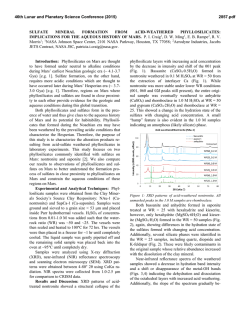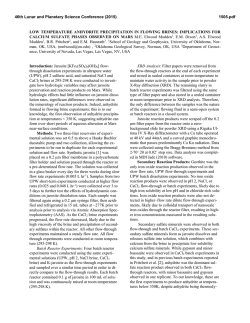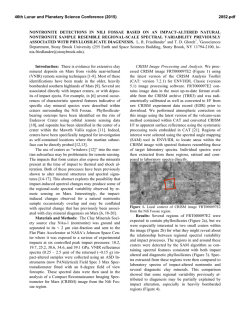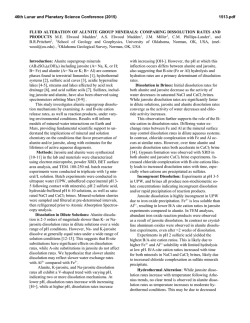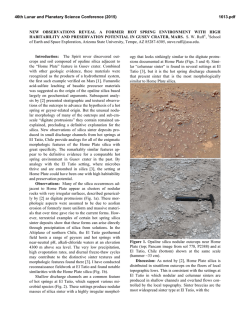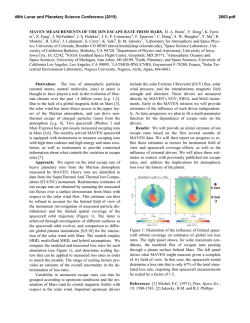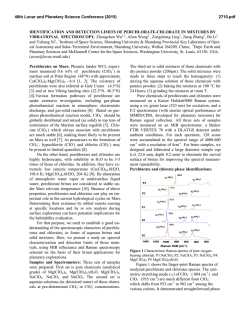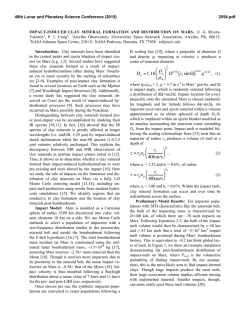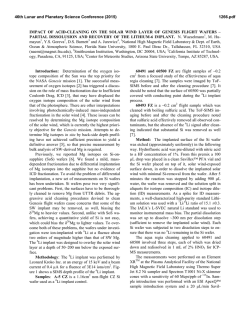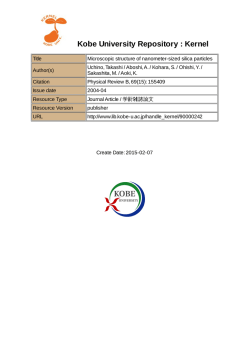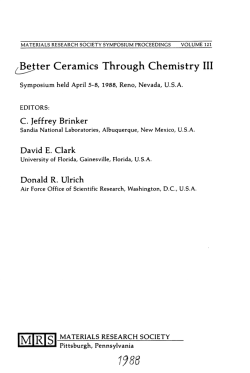
Dissolution of Nontronite in Brines and Implications for Habitable
46th Lunar and Planetary Science Conference (2015) 2350.pdf DISSOLUTION OF NONTRONITE IN BRINES AND IMPLICATIONS FOR HABITABLE ENVIRONMENTS ON MARS. M.S. Steiner1, E.M. Hausrath1, and M.E Elwood Madden 1University of Nevada, Las Vegas 4505 S. Maryland Parkway, Las Vegas NV 89154 [email protected]. 2School of Geology and Geophysics, University of Oklahoma, 100 E. Boyd St., Ste. 710, Norman, OK 73019. Introduction: Liquid water is a necessary ingredient for life on Earth and therefore is likely essential to possible life on Mars. Brines on Earth are able to host life at a wide range of temperature and water activities. While surface conditions on Mars are not able to sustain pure liquid water, brines may exist temporarily [1]. Dissolution rates of olivine, jarosite and basaltic glass in the presence of brines have previously been measured [2, 3, 4]. Nontronite is an iron-rich clay mineral that has been detected on the surface of Mars, particularly in ancient terrains [5, 6]. If an alteration signature could be identified that helps determine the activity of water interacting with nontronite mineral surfaces, such altered nontronite might be able to shed light on the characteristics of possible past habitable environments on Mars. In these experiments, dissolution rates of nontronite were measured as a function of activity of water (aH2O) and temperature. Upon completion, reacted material was examined to attempt to identify an alteration signature indicative of brine dissolution. The results of this work could help interpret past aqueous conditions on Mars and provide a better understanding of the habitability of past martian environments. Methods: The Clay Mineral Society nontronite standard NAu-1 was used for all experiments. Nontronite was crushed and sieved to a size fraction of 40-125µm. Powdered nontronite was ultrasonicated in ethanol at two minute intervals to remove ultra fine particles. Washed material was examined using Scanning Electron Microscopy (SEM) to ensure the removal of ultra fine particles. Experimental Setup: Batch dissolution experiments were designed to measure dissolution as a function of activity of water and temperature. Experiments were designed for aH2O = 1.00, 0.75, and 0.35 solutions using either CaCl2 or NaCl. Solutions of 1.00 aH2O were made using either 0.01 M NaCl or CaCl2, and are similar to natural waters on Earth [7], saturated NaCl and 33 wt% CaCl2 solutions were used as 0.75 aH2O brines, and a 50 wt% CaCl2 solution was used as a 0.35 aH2O brine[8]. All solutions were adjusted to pH 2.0 using high purity HCl. All solutions were used in experiments at 25ºC, and 1.00 aH2O CaCl2 solutions were also used for experiments at 4ºC and 45ºC. Batch reactors were agitated at 100 strokes per minute. Ten ml of sample were removed at each sampling period. The sampling period was three hours, three times a day for one week for all experiments at or above 25ºC and with an activity of water of 0.75 or higher. For experiments with either an activity of 0.35 or at 4ºC, sampling occurred once per day for two weeks. The pH of the sample was measured on a separate aliquot of unfiltered sample, and then the remainder of the 10 ml sample was filtered through a 0.45µm polypropylene syringe filter, acidified to 1% v/v with high purity HNO3, and stored at 20º C until analysis. Each condition was run in duplicate and a blank reactor containing identical solution with no mineral was run along side each set of duplicates to serve as a control. Analyses: SiO2 concentrations were measured with a Thermo Genesys 10S UV-Vis spectrophotometer using a colorometric method optimized for measurement of silica in brines based on ASTM and EPA methods for measuring silica in water[9, 10, 11]. Silica standards were treated in the same way as the samples with matrix-matched standards. At the end of the experiments, the reacted material was rinsed in 18.2 MΩ water and frozen for at least 24 hours before being freeze dried. Freeze dried samples were observed using a JSM-5600 Scanning Electron Microscope and Energy Dispersive Spectroscopy (EDS). SEM provided µm scale images of reacted material while EDS gave a general chemical composition, and images of reacted material were compared to unreacted material. Calculations: Measured concentrations were corrected for the volume of sample removed using the equation [6]: mt = mt-1 + (c(t) – c(t-1))V(t-1) (1) where m is moles of silica released, c is concentration of silica in moles•liter-1, and V is volume in liters. Results: To account for precipitation reactions as the solutions approached equilibrium, we fit the data using the following equation, after [4] ! −𝑚ss 𝑙𝑛 (1 − ) = 𝐴𝑘!"## 𝑡 + 𝐶 (2) !!! where m is moles released of silica, calculated by multiplying the change in [SiO2] by the volume of remaining solution at each time point, Mss is moles released at steady state, A is the surface area, kdiss is the apparent rate constant in mol m-2 s-1, and t is time in seconds. The fastest dissolution rates were observed in dilute experiments, with dissolution rates decreasing as the activity of the water decreased (Figure 1). Similarly, as temperature increased so did the dissolution rate (Figure 2). Using rate constants from all reactors, an activation energy of dissolution was calculated. 46th Lunar and Planetary Science Conference (2015) 2350.pdf SEM images show textured surfaces in both reacted and unreacted material. This textured surface appears more common in samples with low aH2O (Figure 3). Figure 1. Moles silica released as a function of time at aH2O of 1.00, 0.75, and 0.35. Data points are the average of duplicate reactors. Figure 3. Unreacted and reacted surfaces of NAu-1. (A) Unreacted NAu-1observed before dissolution experiments. Reacted NAu-1 removed from reactors (B) 25ºC 1.00 aH2O CaCl2, (C) 25ºC 0.75 aH2O CaCl2, (D) 25ºC 0.35 aH2O CaCl2, (E) 4ºC 1.00 aH2O CaCl2, (F) 45ºC 1.00 aH2O CaCl2. Figure 2. Moles silica released as a function of time at temperatures of 4ºC, 25ºC, and 45ºC. Data points are the average of duplicate reactors. Conclusions: Dissolution of nontronite was slower in brines with low activity of water compared to dilute solutions both in these experiments as well as compared to previous work [13]. The increase in textured surfaces could indicate alteration caused by brine dissolution. Weathered nontronite on Mars may therefore record the conditions under which it was altered, helping interpret past environmental conditions on that planet. Acknowledgments: We would like to acknowledge the Mars Fundamental Research Program, the UNLV Faculty Opportunity Award, the UNLV Graduate and Professional Student Association for travel funding, and Chris Adcock, Seth Gainey, Renee Schofield, Courtney Bartlett, and Angela Garcia for lab assistance. References: [1] Jones, E.G., Lineweaver C.H. (2010) Astrobiology, 10, 349-362. [2] Albright Olsen, A., Hausrath, E.M., Rimstidt, J.D. Journal of Geophysical Research Planets In Review. [3] Dixon, E., Elwood Madden, A. Hausrath, E.M., Elwood Madden, M. Journal of Geophysical Research Planets In Review. [4]Hausrath, E.M. and Brantley, S.L. (2010) Journal of Geophysical Research 115, E12001.[ [5]Thomson, B.J., Bridges, N.T., Miliken, R., Badlridge, A., Hook, S.J., Crowley, J.K., Marion, M., de Souza Filho, C.R. (2011) Icarus, 167, 337-354. [6]Poulet, F., Bibring, J.P., Mustard, J. F., Gendrin, A. Mangold, N., Langevin, Y., Arvidson, R. E. (2005) Nature 438, 623-627. [7] Harter, R.D, Ravendra, N. (2001) Soil Science Society of America Journal 65, 597-612. [8] Pritchett, B.N., Elwood Madden, M.E., Madden, A.S. (2012) Earth and Planetary Science Letters.357-358, 327-336. [9] Govett, G.J.S. (1961) Anal. Chim. Acta, 25, 69-80. [10] APHA, AWAA, and WEF, 2005. Standard Methods for the Examination of Wastewater, 21st ed. American Public Health Association, Wash- ington D.C. [11] ASTM D859-80 (I983), “Standard Test Methods for Silica in Water” [12] Welch S.A., Ullman W.J. (2000) Chemical Geology 167, 337–354. [13] Gainey, S.R., Hausrath, E.M., Hurowitz, J.A., Milliken, R. E. (2014) Geochimica et Cosmochimica Acta 126, 192-211.
© Copyright 2026
